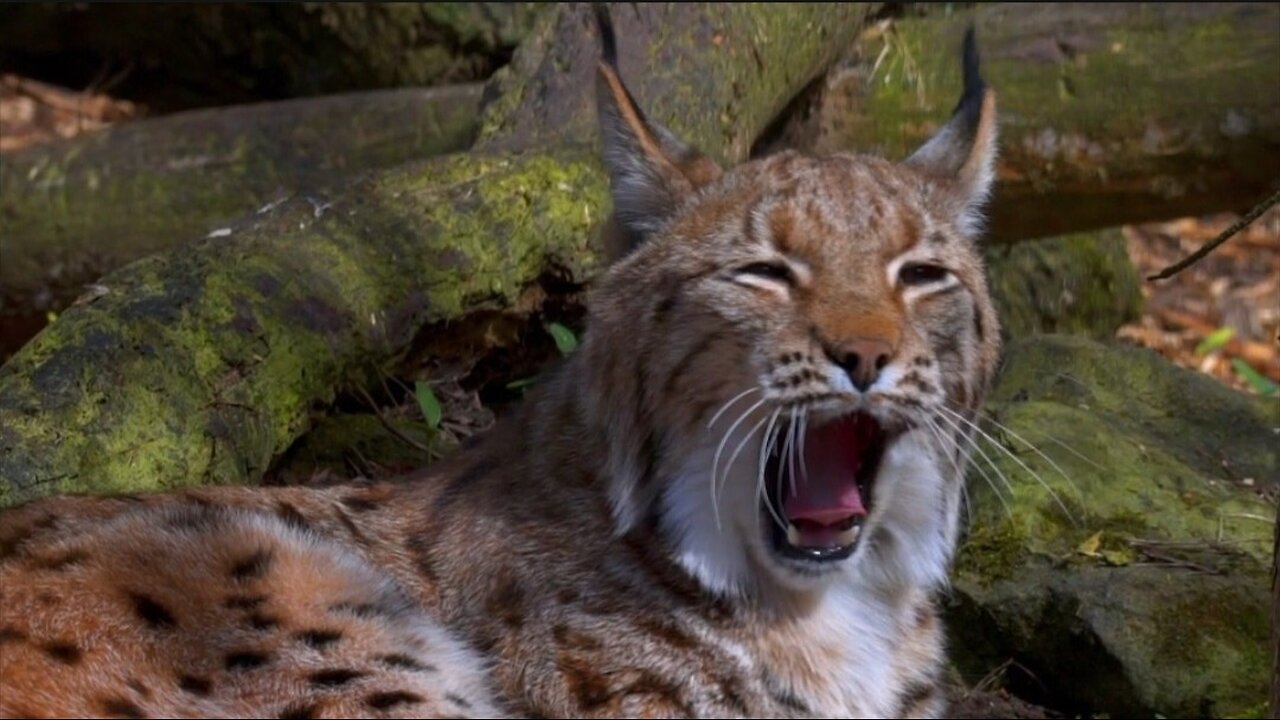Premium Only Content

"Eurasian Lynx: The Mysterious Feline of the Forest"
The Eurasian lynx (Lynx lynx) is one of the most prominent and largest species of lynx, native to the forests, mountains, and steppes across Europe, Central Asia, and Siberia. Known for its striking appearance and stealthy hunting behavior, the Eurasian lynx is a powerful predator and plays a vital role in maintaining ecosystem balance. Here’s a detailed look at this fascinating feline:
Physical Characteristics
Size: The Eurasian lynx is the largest of the four lynx species. Adult males typically weigh between 18-36 kg (40-80 lbs) and measure 80-130 cm (31-51 inches) in length. Females are generally smaller, weighing around 18-25 kg (40-55 lbs).
Coat and Coloration: It has a thick, dense coat that varies in color depending on its habitat and season. The fur is usually yellowish-brown to reddish-brown, covered with dark spots or stripes. In winter, the coat becomes much thicker and may take on a grayer hue for camouflage in snowy environments.
Distinctive Features: The lynx is easily recognized by its short tail with a black tip, large, tufted ears (which help enhance hearing), and long legs that aid in navigating deep snow. The ear tufts also play a role in detecting sounds.
Facial Features: It has a characteristic "beard" of fur beneath its chin, giving it a distinct facial structure compared to other wild cats.
Habitat and Distribution
The Eurasian lynx has a vast range, extending from Europe across to Central Asia, the Russian taiga, and parts of China. The species prefers remote, densely forested regions but is also found in mountainous terrain. It is well-adapted to a variety of environments, from temperate forests to boreal and alpine habitats.
Countries where the Eurasian lynx can be found include Norway, Sweden, Finland, Russia, Romania, the Czech Republic, Germany, and some parts of Central Asia. In recent decades, conservation efforts have reintroduced lynxes into parts of Western Europe, such as the Alps, France, and Germany.
Behavior and Diet
Solitary Lifestyle: Like most wild cats, the Eurasian lynx leads a solitary life, marking its territory with scent markings and scratches on trees. Lynxes are highly territorial, and males typically have larger home ranges than females.
Nocturnal Hunter: Eurasian lynxes are primarily nocturnal or crepuscular, hunting at dusk or dawn. They rely on their keen sense of sight and hearing to locate prey. Their tufts of hair on the ears and large eyes aid in this.
Diet: The Eurasian lynx is a carnivore and primarily hunts ungulates such as roe deer, chamois, and young red deer. In areas where large prey is less abundant, they will also hunt smaller animals like hares, rabbits, birds, and rodents. Lynxes are ambush predators, stalking their prey silently and then pouncing with great agility.
Hunting Technique: The lynx uses its stealth and patience to get as close as possible before striking with a sudden leap. Its powerful limbs help it pin down and subdue larger prey. After making a kill, a lynx may feed on the carcass for several days, burying it under vegetation between meals to keep it hidden from scavengers.
Reproduction and Lifespan
Mating Season: The mating season for Eurasian lynx occurs between February and April. During this period, males will seek out females by following their scent and vocalizations. Otherwise, males and females rarely interact.
Gestation and Birth: After a gestation period of around 67-74 days, female lynxes give birth to a litter of 1-4 kittens in secluded dens, usually under fallen trees, rock crevices, or thick bushes. These dens provide protection from predators and the elements.
Kittens: Lynx kittens are born blind and helpless, weighing about 300-400 grams. Their eyes open after about 10-12 days, and they are nursed by the mother for around 5-6 months. The kittens remain with the mother for up to a year before becoming independent.
Lifespan: In the wild, Eurasian lynxes typically live around 10-12 years, although they can live up to 17-20 years in captivity.
Conservation Status
The Eurasian lynx is classified as Least Concern by the International Union for Conservation of Nature (IUCN), but its populations have faced significant threats in various parts of its range. In Europe, the species was once widespread but became nearly extinct in many regions due to habitat loss, hunting, and depletion of prey. However, thanks to legal protections, conservation programs, and reintroduction efforts, lynx populations have been recovering in several areas.
In regions where the lynx has been reintroduced, such as the Carpathians, the Alps, and the Jura Mountains, it has contributed to the natural control of herbivore populations like deer, which can become overabundant without predators.
.
-
 3:16:02
3:16:02
Barry Cunningham
8 hours agoNEWS ON THE PLOT AGAINST THE PRESIDENT AND IT'S A MOVIE NIGHT!
95.5K57 -
 2:00:32
2:00:32
Glenn Greenwald
10 hours agoWorld Finally Horrified by Israel's Atrocities in Gaza; Mass Starvation Expert Warns of Spiraling Crisis in Gaza; AOC Votes to Fund Israel's Iron Dome | SYSTEM UPDATE #489
99.4K142 -
 LIVE
LIVE
Spartan
7 hours agoSpartan - Pro Halo Player for OMiT | Scrims vs OMiT Black
515 watching -
 2:47:11
2:47:11
crgoodw1n
6 hours agoMonday stream Pt.2! Max Traders are almost here!
26.2K1 -
 1:28:30
1:28:30
Gurk
5 hours ago $0.58 earnedMLB CO OP
29.1K -
 1:46:27
1:46:27
Tim Pool
14 hours agoSin Frontera: The End of Illegal Immigration
203K70 -
 3:42:40
3:42:40
VapinGamers
6 hours ago $1.75 earnedDestiny 2 - Edge of Fate Legendary Run and AD Testing RTMP Pass Thru - !rumbot !music
23.8K3 -
 2:24:23
2:24:23
Joker Effect
6 hours agoULTRA MEGA STREAM! Let's review things... Also... Joker was right... again! What a surprise :) Also.. what the heck is @NetAxisGroup ?
16.5K -
 1:01:11
1:01:11
Jamie Kennedy
1 day agoWhy the Epstein Cover-Up Still Matters | Ep 214 HTBITY W Jamie Kennedy
16.7K3 -
 2:11:56
2:11:56
LIVE WITH CHRIS'WORLD
1 day agoLIVE WITH CHRIS'WORLD - WE ARE READY FOR ACCOUNTABILITY
12.2K9